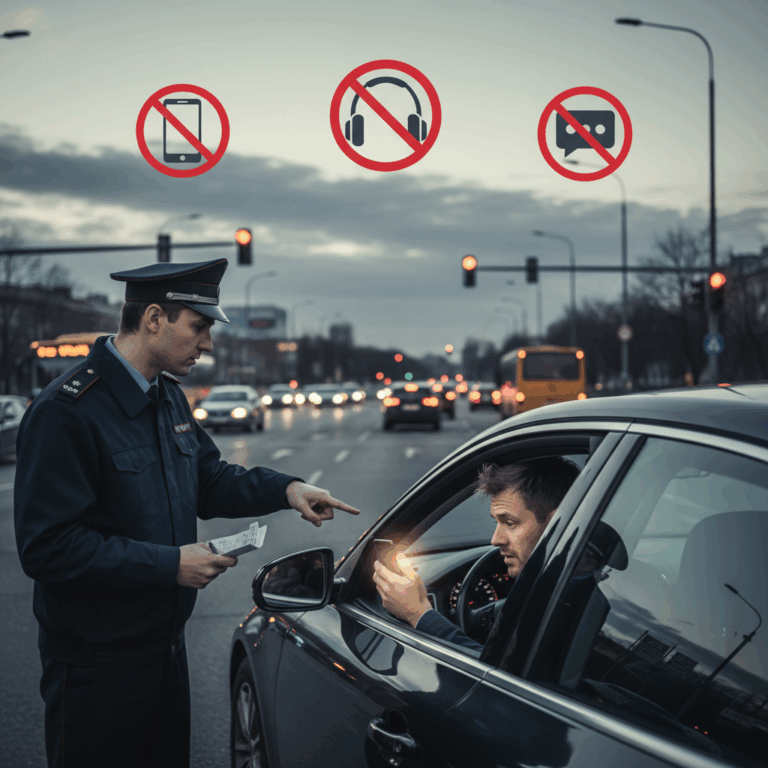Global Variations in Distracted Driving Laws
Distracted driving laws vary significantly across the globe, reflecting diverse approaches to enhancing road safety. Different countries implement unique legal frameworks and penalties to address this critical issue.
These laws aim to reduce accidents caused by distractions, particularly mobile phone use. Enforcement and penalties differ not only internationally but also regionally within some countries.
The effectiveness of these laws depends on consistent application and public education to encourage responsible driving behaviors worldwide.
Legal Restrictions and Penalties in Europe
In Europe, distracted driving is taken very seriously, with strict laws against mobile phone use while driving. For example, Spain bans phone use unless a hands-free system is employed.
Violators in Spain face fines up to 200 euros and risk losing 6 points on their driving license. The UK enforces similar measures, imposing fines up to £200 and penalty points for mobile use while driving.
Such regulations emphasize preventing driver distractions to lower accident rates and promote safer road environments across European countries.
State-Based Regulations in the United States
In the U.S., distracted driving laws vary by state, reflecting diverse regulatory approaches. States like California and Nevada have strict bans on handheld mobile phone use while driving.
Nevada enforces particularly strong rules, prohibiting texting and calls on handheld devices with escalating fines for repeat offenders. This highlights regional efforts to combat distractions.
Each state’s law is tailored to address local concerns, but all aim to improve road safety by discouraging distracted driving practices.
Distracted Driving Laws in Specific Countries
Governments worldwide have adopted distinct approaches to tackle distracted driving, especially regarding mobile phone use behind the wheel.
These country-specific laws reflect varying enforcement levels and penalties to curb this dangerous behavior and enhance road safety.
Understanding these differences helps highlight global efforts to reduce accidents caused by distracted driving.
Spain’s Approach to Mobile Phone Use
Spain strictly prohibits the use of mobile phones while driving unless a hands-free system is utilized. This measure targets minimizing driver distractions on busy roads.
Penalties include fines up to 200 euros and the deduction of 6 points from the driver’s license, emphasizing the seriousness of this offense.
Such rules aim to encourage drivers to remain focused, reducing accident risks caused by phone-related distractions.
The United Kingdom’s Enforcement Measures
The UK enforces strict punishments for drivers caught using mobile phones. Fines can reach £200, accompanied by penalty points on the driving license.
These regulations apply to all handheld phone use, reinforcing responsible driving through legal deterrents.
Authorities regularly conduct roadside checks and public campaigns to ensure awareness and compliance with the law.
Australia’s Nationwide Mobile Device Ban
Australia imposes a nationwide ban on mobile phone usage while driving, applicable across all states and territories.
Violations can result in fines and points deducted from the driver’s license, aiming for consistent enforcement regardless of location.
Cities like Sydney employ camera systems to detect offenders, complementing law enforcement efforts with advanced technology.
Examples from Select U.S. States
In the United States, distracted driving regulations differ statewide. California and Nevada exemplify strict laws against handheld phone use.
Nevada’s laws prohibit texting and calling on handheld devices while driving, with escalating fines for repeated violations, showcasing stringent enforcement.
These regulations reflect a growing trend across states to adopt tougher measures to protect road users from distracted driving dangers.
Enforcement Technologies and Methods
Law enforcement agencies increasingly rely on advanced technologies to detect and prevent distracted driving. These innovations improve monitoring accuracy and help enforce existing regulations.
Technologies such as artificial intelligence (AI) and sensors enable real-time analysis of driver behavior, identifying distractions like mobile phone use more effectively than traditional methods.
The integration of these tools supports safer roads by aiding authorities in punishing offenders and promoting compliance with distracted driving laws worldwide.
Use of AI and Sensor Technology
AI-powered cameras and sensors are revolutionizing distracted driving enforcement by automatically detecting phone usage. These systems analyze hand and eye movements to spot violations without human error.
Such technologies provide objective evidence for issuing fines and warnings, enhancing law enforcement capabilities in various countries, including Australia and the UK.
Furthermore, sensor integration in vehicles can alert drivers directly, promoting safer habits before an accident occurs.
Public Awareness and Education Efforts
Public awareness campaigns play a vital role in reducing distracted driving by informing drivers about its dangers. These efforts use diverse media to reach broad audiences.
Education initiatives emphasize the severe consequences of distractions while driving, urging individuals to maintain full attention behind the wheel.
Through consistent messaging and community involvement, these programs aim to foster long-term behavioral change and safer roads.
Awareness Campaigns to Reduce Distracted Driving
Many countries implement campaigns highlighting the risks of using mobile phones while driving. These campaigns often involve advertisements, social media, and public events.
By showcasing real accident stories and statistical data, the campaigns create emotional engagement and increase driver caution.
Such efforts have proven effective in raising public consciousness and encouraging compliance with distracted driving laws.
Collaboration between governments and NGOs further strengthens the impact of these initiatives, ensuring consistent risk communication.
Driver Education on Risks and Responsibilities
Driver education programs incorporate modules about the dangers associated with distracted driving. These lessons target new drivers and experienced ones alike.
Training emphasizes personal accountability, teaching drivers how distractions impair reaction time and decision-making on the road.
Schools, driving academies, and online courses play key roles in delivering this education, promoting safer driving habits from the start.
Impact of Education on Road Safety
Studies show that well-structured educational programs significantly decrease incidents of distracted driving by raising awareness and changing attitudes.
Education fosters a deeper understanding of legal consequences and encourages responsible driving behavior, ultimately improving traffic safety.







